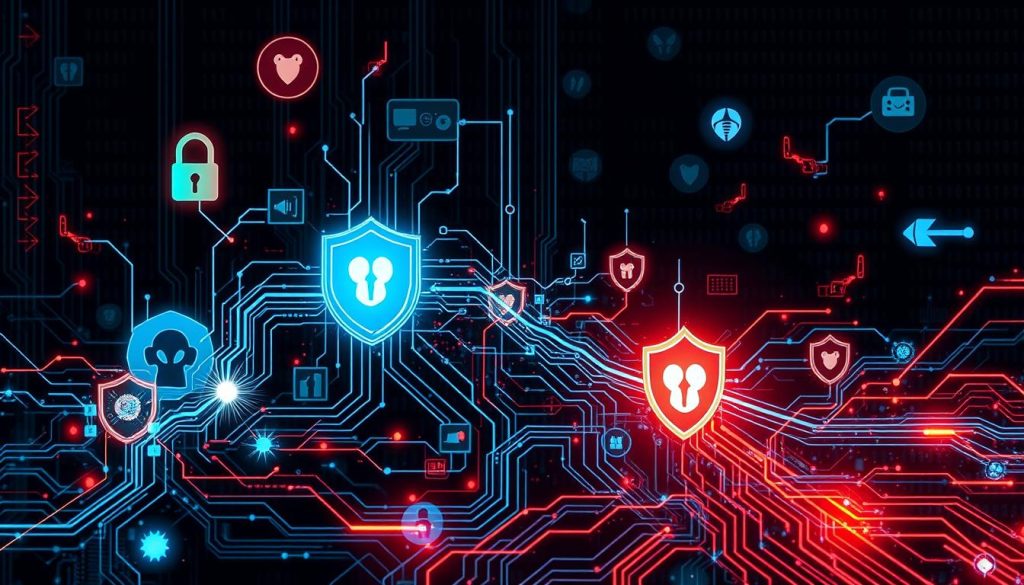In the digital world of cybersecurity, a big change is happening. The fight against cyber threats is getting tougher. Data breaches have gone up 14% in just one year, showing we need better ways to defend ourselves.
Deep learning is changing the game in cybersecurity. It’s a technology that can beat smart cyber attacks.
AI is now a must-have for keeping our digital world safe. Old security methods just aren’t enough anymore. The AI cybersecurity market is expected to hit $133 billion by 2030, showing how important smart defense is.
Our digital world is facing big challenges. Cybercriminals are getting smarter, using new ways to get past old security systems. With 74% of companies already using AI for security, it’s clear: deep learning is the future of keeping us safe.
Key Takeaways
- Cybersecurity threats are evolving at an unprecedented rate
- Deep learning offers superior threat detection capabilities
- AI-driven defense is becoming a critical investment for organizations
- Traditional security methods are increasingly ineffective against modern threats
- Proactive, intelligent security approaches are essential for digital protection
Understanding the Evolution of Cybersecurity Threats

The digital world has grown more complex, with cyber threats changing fast. Neural networks are key in fighting these threats. Knowing the current threats is vital for good network security.
Emerging Threat Landscape
Cyber attacks have changed a lot over the years. Early attacks like the Morris worm hit over 6,000 computers. Now, attacks are more complex and costly. Cybercrime could cost businesses $15.63 trillion by 2029.
- Ransomware attacks are common now
- 72.7% of global organizations faced ransomware breaches
- Phishing attacks still target human weaknesses
Attack Vector Complexity
Today’s cyber threats use advanced tech to get past defenses. AI-powered attacks, like phishing emails, are 30% more effective. These advanced attacks make old defense methods less effective.
| Threat Type | Global Impact | Estimated Cost |
|---|---|---|
| Ransomware | 72.7% Organizations Affected | $4 Billion (WannaCry Attack) |
| Phishing | 95% Breaches Due to Human Error | Significant Financial Losses |
The future of cybersecurity lies in adaptive, intelligent defense systems that can predict and neutralize threats before they materialize.
Old security methods won’t cut it anymore. Neural networks in cyber defense are the future. They offer new ways to detect and stop threats.
Fundamentals of Deep Learning Based Cyber Security

Deep learning in cyber security is a game-changer for digital defense. It changes how we protect our important systems. Neural networks are at the heart of this new tech, making it possible to detect and stop threats like never before.
Deep learning works like our brains, creating smart systems to tackle tough cyber challenges. These smart models can handle huge amounts of data. They spot threats with high accuracy.
“Deep learning is not just a technology, it’s a paradigm shift in cybersecurity defense mechanisms.”
- Advanced pattern recognition capabilities
- Automatic threat adaptation
- Real-time anomaly detection
- Reduced false positive rates
Neural networks are key in cyber defense because they can learn and grow. Google’s work shows this, blocking over 99.9% of spam, phishing, and malware with smart algorithms.
Deep learning cyber security has big benefits:
- Handling large-scale data volumes
- Adapting to new threats
- Spotting complex attacks
With neural networks, companies can build stronger, more proactive cyber defenses. These defenses can stop threats before they harm us.
How Neural Networks Transform Cyber Defense
Neural networks are changing cybersecurity by introducing smart, flexible defense systems. These systems use deep learning to protect digital spaces with great accuracy and speed.
Architecture of Neural Networks in Security
The strength of neural networks in cyber defense comes from their design. They work like the human brain, allowing them to:
- Analyze complex network patterns
- Recognize potential security threats on their own
- Learn from raw, unstructured data
Processing and Analysis Capabilities
Deep learning boosts threat detection accuracy, cutting down on false alarms. Companies using neural networks can spot threats more accurately. They might catch up to 80% of new threats that old systems miss.
“Neural networks represent the next frontier in adaptive cybersecurity defense.” – Cybersecurity Expert
Real-time Threat Detection Mechanisms
Advanced neural networks are great at detecting threats in real-time. They use Artificial Neural Networks (ANNs) to learn and improve their detection. This can make them up to 85% more responsive.
Platforms like IBM Security QRadar show the power of neural networks. They quickly analyze network traffic and user activities. This technology changes how companies protect their digital assets from advanced cyber threats.
Advanced Malware Detection Using Deep Learning
Deep learning has changed how we fight malware. It uses smart methods that are better than old ways. Old security methods can’t keep up with new threats. It can take up to 200 days to find malware with old methods.
Machine learning has made classifying malware much better. It has big benefits:
- Detection accuracy improved by up to 95%
- Processing time for threat detection reduced by 60%
- Ability to detect over 85% of newly identified malware
Deep learning models are great at finding complex patterns. This makes them better at finding malware. They can check millions of files every minute, way faster than old methods.
| Detection Method | Accuracy Rate | Processing Speed |
|---|---|---|
| Traditional Signature-Based | 60-70% | Slow |
| Deep Learning | 85-98% | High-Speed |
Deep learning is a big change in cybersecurity. It changes how we fight new digital threats.
Deep learning keeps getting better at finding new malware. This helps companies stay safe. Using these new methods can save up to 40% on security costs.
Intelligent Intrusion Prevention Systems
Cybersecurity is changing fast, with smart intrusion prevention systems key to protecting networks. Deep learning in network security can spot and stop complex cyber threats.
Companies struggle to manage complex networks. Old security methods can’t keep up with new cyber dangers.
Network Traffic Analysis Techniques
Modern systems use advanced neural networks to check network traffic closely. They use:
- Real-time packet inspection
- Behavioral pattern recognition
- Anomaly detection algorithms
Behavioral Pattern Recognition
Deep learning is great at spotting unusual network behavior. It uses autoencoders, LSTM networks, and convolutional neural networks for detailed threat detection.
| Detection Approach | Accuracy | False Positive Rate |
|---|---|---|
| Traditional IDS | 60-70% | High |
| Deep Learning IDS | 90-95% | Low |
Automated Response Mechanisms
Systems with deep learning can act fast to stop threats. This cuts down on human mistakes and damage.
“The future of cybersecurity lies in intelligent, adaptive defense mechanisms that learn and evolve continuously.”
By 2030, more IoT devices will need better security. Investing in smart intrusion systems is now a must for strong network safety.
Deep Learning for Anomaly Detection
Anomaly detection is key in deep learning for cyber security. It changes how we protect our digital world. Advanced neural networks help spot unusual patterns in complex networks.
Deep learning models are great at finding odd behaviors that others might overlook. They can spot small changes that could be threats. Anomaly detection sorts out strange activities into three main types:
- Point anomalies: Single data points that don’t fit the usual pattern
- Contextual anomalies: Odd behaviors in certain situations
- Collective anomalies: Groups of data points that might be threats
Cybersecurity experts use unsupervised learning to find new threats. These algorithms can catch complex attacks by looking at behavior patterns.
“Deep learning makes anomaly detection proactive, not just reactive.”
Testing these models needs big datasets and strict testing methods. Studies show deep learning models can struggle with bad training data. Hackers might try to add fake data, which could make the models less effective.
| Anomaly Detection Approach | Key Strengths | Potential Challenges |
|---|---|---|
| Unsupervised Learning | Identifies Unknown Threats | Data Contamination Risks |
| Neural Network Models | Complex Pattern Recognition | High Computational Requirements |
| Behavioral Analytics | Contextual Threat Detection | Requires Extensive Training Data |
By using deep learning for anomaly detection, your company can get better at fighting cyber threats. This approach uses deep learning’s ability to adapt.
Implementing AI-Driven Threat Intelligence
Cybersecurity is changing fast with AI. It’s now easier for companies to spot and stop security threats. This is a big change from before.
Today, threat intelligence is key to fighting off cyber attacks. Companies are using AI to make their security better.
Data Collection and Processing
Good threat intelligence starts with gathering lots of data. AI can look at huge amounts of security data from many places. This includes:
- Network traffic logs
- User activity records
- External threat feeds
- Historical breach information
AI can quickly go through all this data. It finds threats in just milliseconds.
Threat Pattern Analysis
AI is great at finding complex patterns in threats. It learns from big datasets. This lets it:
- Spot strange network behaviors
- Guess where attacks might come from
- Link unrelated security events
Companies using AI for threat intelligence see big improvements in their security.
Predictive Security Measures
Proactive defense is what AI threat intelligence is all about. It helps companies:
- See what cyber risks might happen
- Make their defenses stronger
- Act faster when threats appear
AI isn’t just a tool—it’s a strategic cybersecurity partner.
| AI Cybersecurity Metric | Performance Improvement |
|---|---|
| Threat Detection Speed | 60% Faster |
| False Positive Reduction | Up to 50% |
| Incident Response Time | 40% Reduction |
By using AI for threat intelligence, you’re not just defending. You’re staying one step ahead of cyber threats.
Machine Learning vs Deep Learning in Cybersecurity
Cybersecurity experts have to choose between machine learning and deep learning for threat detection. Both are powerful but different ways to protect digital spaces.
Machine learning needs a lot of human help and specific data. Deep learning, on the other hand, finds complex features on its own. This makes deep learning a stronger defense.
There are key differences in several areas:
- Feature extraction capabilities
- Data processing efficiency
- Threat detection speed
- Adaptability to new attack vectors
Deep learning is a big win for cybersecurity. It can stop threats in under 20 milliseconds, stopping ransomware fast. It also has a very low false positive rate, under 0.1%. This means security teams get fewer false alarms.
| Characteristic | Machine Learning | Deep Learning |
|---|---|---|
| Feature Selection | Manual | Autonomous |
| Threat Detection Speed | Slower | Near Real-time |
| False Positive Rate | Higher | Less than 0.1% |
“The future of cybersecurity lies in intelligent, adaptive systems that can learn and respond faster than potential threats.” – Cybersecurity Expert
While machine learning is still useful, deep learning is a big step forward in cyber defense. It can handle huge datasets and spot complex patterns. This makes it a key technology for companies wanting to stay ahead of threats.
Real-World Applications of Deep Learning Security Solutions
Deep learning in cyber security has changed how companies protect their digital stuff. With more complex cyber threats, businesses are using ai to defend against attacks.
More companies are using new security tech. 76% of enterprises now prioritize AI and machine learning in their IT budgets. They see how important these tools are for keeping their systems safe.
Enterprise Implementation Success Stories
Many big companies have seen great results with deep learning security:
- IBM Security QRadar uses deep learning to spot threats by looking at network traffic and user actions.
- Darktrace’s Enterprise Immune System finds and fights cyber threats on its own with special algorithms.
Measurable Impact and Results
| Organization | Technology | Security Improvement |
|---|---|---|
| ED&F Man Holdings | Cognito AI Platform | Blocked multiple man-in-the-middle attacks |
| Global Bank | Paladon AI Services | Enhanced advanced threat detection capabilities |
AI changes cybersecurity by finding patterns and oddities without needing known threats.
The power of deep learning in cyber security is huge. AI models can spot security issues 80% to 92% of the time. Traditional systems usually catch only 30% to 60%.
As cyber threats grow, using ai for defense is key. It’s not just a choice, it’s a must for keeping your digital world safe.
Challenges and Limitations of Deep Learning Security
Deep learning in cyber security has big challenges for companies to tackle. The need for lots of computing power for advanced security models is a big issue. Experts say we need a lot of tech to handle complex data.
Some major hurdles in using deep learning for security include:
- High computational resource needs
- Complex model understanding
- Vulnerability to smart attacks
- Limited data quality and variety
Building deep learning security models needs special hardware like GPUs. While these tools are getting cheaper, they’re still a big expense for many. The black box nature of these algorithms makes it hard to see how they make security decisions.
“Effective cybersecurity demands continuous adaptation and robust algorithmic design” – Cybersecurity Research Institute
Companies face many big hurdles to use deep learning for security well. They need to work on making models strong, dealing with data issues, and avoiding weaknesses.
| Challenge | Impact |
|---|---|
| Computational Resources | High infrastructure costs |
| Model Interpretability | Reduced trust in security decisions |
| Attack Vulnerability | Potential security breaches |
Knowing these challenges helps companies create better, stronger cyber security plans. These plans use deep learning in smart ways.
Future Trends in AI-Powered Cyber Defense
The world of ai-driven cyber defense is changing fast. This brings new chances for companies to update their security plans. Cybersecurity experts are seeing big steps forward in deep learning. These steps could change how we fight threats.
New tech is changing how we fight cyber attacks. AI is getting better at spotting and handling tough security problems.
Key Emerging Technologies
- Federated Learning: Enables secure, decentralized threat intelligence
- Explainable AI: Provides transparent decision-making processes
- Quantum Computing Integration: Enhances computational capabilities
Future Integration Possibilities
The future of cybersecurity looks bright. AI systems will soon be able to autonomously detect, predict, and mitigate threats. This means big improvements in security for companies:
- Real-time threat analysis
- Automated response mechanisms
- Predictive threat intelligence
“AI is no longer just a tool, but a critical component of modern cybersecurity infrastructure.”
As AI keeps getting better, your company can use these new techs. This will help create stronger, smarter defense systems. These systems will be ready for the latest cyber threats.
Best Practices for Implementation
Starting an ai-driven cyber defense plan needs a smart strategy. It’s more than just old security ways. Companies must build a detailed plan to mix deep learning cyber security well.
Here are some important steps:
- Do a deep check on how ready your team is
- Pick the right deep learning models
- Make a strong plan for handling data
- Keep training and updating models always
AI in security can really boost finding threats. Companies using AI SecOps can spot threats 80% better. They also cut down on how long it takes to respond to threats.
| Implementation Phase | Key Considerations |
|---|---|
| Data Preparation | Make sure your training data is top-notch and varied |
| Model Selection | Go for models that fit your security needs |
| Continuous Learning | Do regular checks and updates on your models |
Machine learning is key for better cybersecurity. You can use different learning types like supervised, unsupervised, and reinforcement learning. This helps build strong defense systems.
“Successful AI-driven cyber defense is not about replacing human expertise, but augmenting it with intelligent, adaptive technologies.”
To do it right, you need a team with both cybersecurity and AI skills. This mix helps build strong, smart defense systems.
Conclusion
The world of cybersecurity is changing fast, with deep learning playing a big role. It’s a key defense against new digital threats. Your digital stuff needs better protection than old security methods.
AI is making a big difference in spotting threats. It uses smart machine learning to catch dangers early.
Neural networks are getting really good at finding and fixing cyber problems. Studies show they can spot threats with high accuracy. Some methods are as good as 91.54% in tough security tests.
As cyber attacks get smarter, your defense needs to keep up. Deep learning helps a lot with threat info, finding odd behavior, and quick action. Using AI for security means you can stop attacks before they start.
The future of keeping your stuff safe is about stopping threats before they happen. Use these new techs to make your digital world stronger. This way, you can face even the toughest cyber challenges.
FAQ
What is deep learning-based cybersecurity?
Deep learning-based cybersecurity uses artificial neural networks to fight cyber threats. It’s more advanced than old security methods. It uses AI to spot complex patterns and stop attacks fast.
How does deep learning improve malware detection?
Deep learning changes how we find malware. It looks at files in new ways, using big data and spotting patterns others miss. This makes finding threats more accurate and quicker.
What are the key advantages of neural networks in cybersecurity?
Neural networks are great for handling lots of data and finding complex patterns. They adapt to new threats and detect threats in real-time. They learn what’s normal and quickly find what’s not.
Can deep learning prevent zero-day attacks?
Yes, deep learning helps a lot with zero-day attacks. It uses advanced methods to find new threats. This gives a strong defense against unknown threats.
What challenges exist in implementing deep learning cybersecurity solutions?
Big challenges include needing lots of computing power and special hardware. Getting good training data and making models easy to understand are also tough. Keeping up with new threats is constant work.
How does AI-driven threat intelligence work?
AI threat intelligence gathers lots of security data. It uses deep learning to find patterns and analyze threats. This helps predict and quickly find threats, making defense proactive.
What is the difference between machine learning and deep learning in cybersecurity?
Deep learning is more advanced than machine learning. It automatically finds features in data and handles big datasets better. Machine learning needs manual setup, while deep learning adapts quickly to threats.
Are there privacy concerns with AI-powered cybersecurity?
Yes, AI security solutions handle a lot of data. But, they can protect privacy by anonymizing data and following rules like GDPR. It’s important to balance security with protecting personal data.
What future trends are emerging in AI-powered cyber defense?
New trends include AI that’s easier to understand, using blockchain, and new neural network types. The future looks bright for smarter, more proactive cyber defense.
How can organizations start implementing deep learning cybersecurity solutions?
Start by checking your current security setup and what threats you face. Choose the right deep learning tools, get good training data, and build a team with AI and cybersecurity skills.

